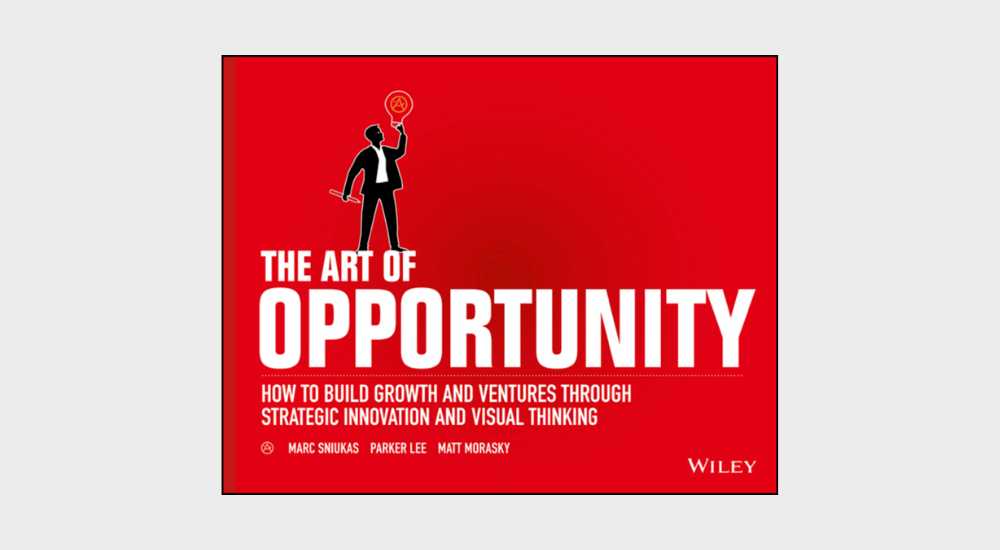Confront the Brutal Facts — Is your Strategy Really Working?
When you start thinking about your strategy, you first need to honestly evaluate what is going on, both inside your organization and in the market....
Shareholders are no longer the only constituency for whom companies need to create value. In ‘The Art of Opportunity: How to Build Growth and Ventures through Strategic Innovation & Visual Thinking’ we describe how strategically innovative companies achieve sustainable success and growth by creating value and benefits for multiple stakeholders.
Your strategy, which we define as the combination of your offering (the products, services and customer experiences you provide), your business model (the activities you perform and how you perform them), and your revenue model (the combination of revenue streams, pricing mechanisms and payment methods), needs to create value for your customers, your company, and the ecosystem you’re embedded in.
In order for your company to stay competitive, your strategy — defined here as the combination of your product and service offerings, business model and revenue model — needs to create benefits for your customers. How? By solving their needs and jobs to be done. Your strategy should address your customers’ hurdles to consumption and barriers to satisfaction, make their lives easier and more convenient, and make the customer experience more exciting. It often pays to consider multiple customers. The final user might not be the buyer or the decision maker. Have you thought about all the customers that are part of the buying process? Does your strategy create value for all of them?
Evaluate whether your strategy creates value for customers:
(You can rate each question on a scale: Strongly disagree -2, Disagree -1, Neither / Nor 0, Agree +1, Strongly Agree +2. Assign value ranging from -2 to +2 to each score.)
Your strategy should also create value for your organization, obviously. These benefits can be threefold.
Strategic benefits include competitive advantage through differentiation, a unique position in the market and the creation of superior value for the customer, market share, brand and reputation. Strategic benefits also include the future potential that a certain offering, business model, or revenue model creates for your company. In the case of Amazon, its online business model has enabled it to expand from books into all sorts of product areas — a possibility that the traditional bookstore does not offer. In addition, the underlying assets and capabilities necessary to operate the Amazon business model have created further opportunities to venture into online web services, logistics, and payment services.
Operational benefits include higher flexibility and speed in terms of reaction to the market, higher degrees of asset utilization, and inventory turnover.
Financial benefits include increased performance in terms of growth in revenues, lower cost (and thus higher profits), reduced capital investment, and the transformation of fixed cost into variable cost.
Evaluate whether your strategy creates value for your firm:
(You can rate each question on a scale: Strongly disagree -2, Disagree -1, Neither / Nor 0, Agree +1, Strongly Agree +2. Assign value ranging from -2 to +2 to each score.)
Finally, value should also be created for other stakeholders and parties involved in the wider ecosystem. If your organization relies on partners, why should they do business with you if you don’t create any value for them? Ecosystem benefits can have the same form as the value created for your firm and be of strategic, operational and financial nature.
For example, the tutoring offering for kids of 826 Valencia, a non-profit organization operating out of a pirate supply store in San Francisco, creates value for students (who get better at their schoolwork), as well as for parents (who don’t need to spend as much time helping their children to study and are proud of their kids when they receive better grades). Giving teachers and volunteers the possibility to work with the students creates emotional value for them, as they can give back to the kids and the communities they are part of.
Evaluate whether your strategy creates value for your firm:
(You can rate each question on a scale: Strongly disagree -2, Disagree -1, Neither / Nor 0, Agree +1, Strongly Agree +2. Assign value ranging from -2 to +2 to each score.)
Is your strategy creating value? Looking at the results of your assessment, is your strategy truly creating value?
If your score is between 0–3, I’m afraid it is not. A score of 4–5 indicates your value creation is still very low. Between 6–7 indicates the value your strategy creates is pretty high, yet your organization is not leading your industry yet. A score of 8–10 indicates that your organization is a true value creation champion.
What to do if your score is low?
Have a look at the results from each category. Is there one with a particularly low score? Excellent! Therein lies an opportunity for new growth and innovation to be seized!
If your customer value proposition is low, you probably need to understand customers, their needs, jobs to be done, and customer experience better. What are the barriers to creating a satisfactory customer experience and high value for them? Which areas of your strategy, your offering, business model, or revenue model, can be enhanced to create more value for them?
If your firm value proposition is low, you will want to assess your resources and capabilities. How well are you leveraging your strongest ones? Can you improve your offering, that is, your products, services, and the customer experience? How well does your business model work? Does it focus on high value creating activities? How well is your revenue model suited to fulfill your needs and those of your customers?
If your strategy’s ecosystem value proposition is low, as is often the case, you will probably want to start understanding your partners’ needs better. What are their strategic, operational, and financial challenges? How can your strategy be tweaked to support them better, and hence create stronger relationships? How can you leverage these relationships to enhance the value created for your customers and your firm?
The winners in today’s economies create value and benefits for multiple stakeholders.
Only by creating value for customers, your company, and your ecosystem will your strategy be successful and your organization stay relevant.
To learn more on these three types of value propositions, and how to create them, check The Art of Opportunity.

When you start thinking about your strategy, you first need to honestly evaluate what is going on, both inside your organization and in the market....

Amazon #1 Best-selling new release on innovation Amazon Top 5 on innovation Amazon Top 10 on strategic management Amazon Top 10 on strategy &...

The importance of strategy today. Strategy is now more critical than ever. In turbulent times the seduction to keep on doing what you're doing,...